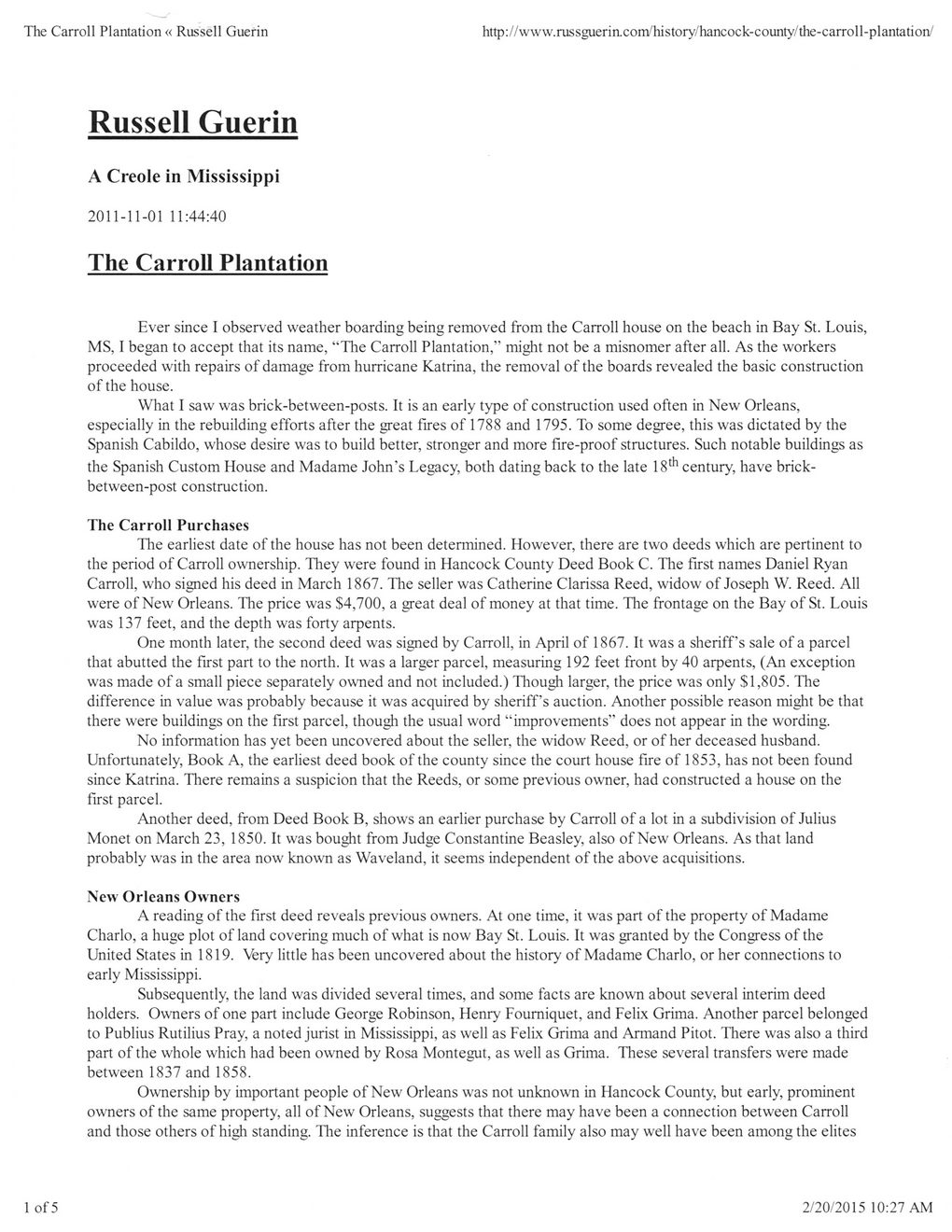This text was obtained via automated optical character recognition.
It has not been edited and may therefore contain several errors.
The Carroll Plantation « Russell Guerin http://www.russguerin.com/history/hancock-county/the-carroll-plantation/ Russell Guerin A Creole in Mississippi 2011-11-01 11:44:40 The Carroll Plantation Ever since I observed weather boarding being removed from the Carroll house on the beach in Bay St. Louis, MS, I began to accept that its name, “The Carroll Plantation,” might not be a misnomer after all. As the workers proceeded with repairs of damage from hurricane Katrina, the removal of the boards revealed the basic construction of the house. What I saw was brick-between-posts. It is an early type of construction used often in New Orleans, especially in the rebuilding efforts after the great fires of 1788 and 1795. To some degree, this was dictated by the Spanish Cabildo, whose desire was to build better, stronger and more fire-proof structures. Such notable buildings as the Spanish Custom House and Madame John’s Legacy, both dating back to the late 18th century, have brick-between-post construction. The Carroll Purchases The earliest date of the house has not been determined. However, there are two deeds which are pertinent to the period of Carroll ownership. They were found in Hancock County Deed Book C. The first names Daniel Ryan Carroll, who signed his deed in March 1867. The seller was Catherine Clarissa Reed, widow of Joseph W. Reed. All were of New Orleans. The price was $4,700, a great deal of money at that time. The frontage on the Bay of St. Louis was 137 feet, and the depth was forty arpents. One month later, the second deed was signed by Carroll, in April of 1867. It was a sheriffs sale of a parcel that abutted the first part to the north. It was a larger parcel, measuring 192 feet front by 40 arpents, (An exception was made of a small piece separately owned and not included.) Though larger, the price was only $1,805. The difference in value was probably because it was acquired by sheriffs auction. Another possible reason might be that there were buildings on the first parcel, though the usual word “improvements” does not appear in the wording. No information has yet been uncovered about the seller, the widow Reed, or of her deceased husband. Unfortunately, Book A, the earliest deed book of the county since the court house fire of 1853, has not been found since Katrina. There remains a suspicion that the Reeds, or some previous owner, had constructed a house on the first parcel. Another deed, from Deed Book B, shows an earlier purchase by Carroll of a lot in a subdivision of Julius Monet on March 23, 1850. It was bought from Judge Constantine Beasley, also of New Orleans. As that land probably was in the area now known as Waveland, it seems independent of the above acquisitions. New Orleans Owners A reading of the first deed reveals previous owners. At one time, it was part of the property of Madame Charlo, a huge plot of land covering much of what is now Bay St. Louis. It was granted by the Congress of the United States in 1819. Very little has been uncovered about the history of Madame Charlo, or her connections to early Mississippi. Subsequently, the land was divided several times, and some facts are known about several interim deed holders. Owners of one part include George Robinson, Henry Foumiquet, and Felix Grima. Another parcel belonged to Publius Rutilius Pray, a noted jurist in Mississippi, as well as Felix Grima and Armand Pitot. There was also a third part of the whole which had been owned by Rosa Montegut, as well as Grima. These several transfers were made between 1837 and 1858. Ownership by important people of New Orleans was not unknown in Hancock County, but early, prominent owners of the same property, all of New Orleans, suggests that there may have been a connection between Carroll and those others of high standing. The inference is that the Carroll family also may well have been among the elites 1 of 5 2/20/2015 10:27 AM

Carroll Plantation Guerin-Article-(1)